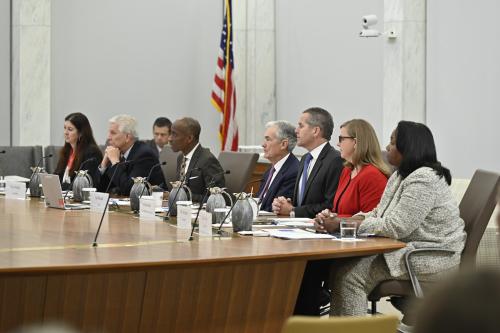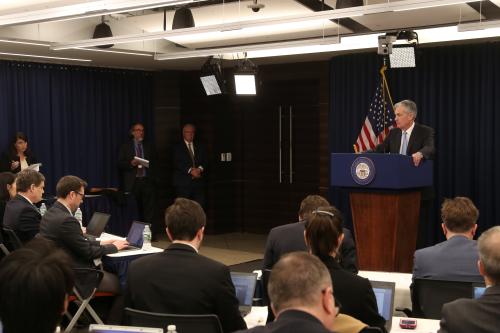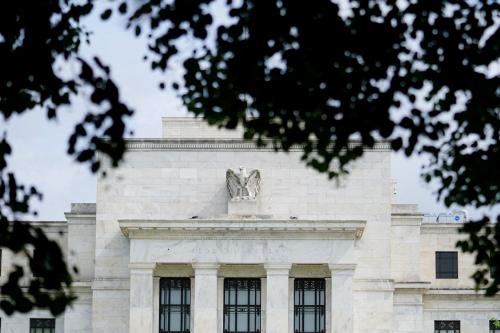President Trump has made no secret of his dissatisfaction with the Federal Reserve, its chair, and the Fed’s monetary policy. This dissatisfaction raises an important question: what happens next? Here’s an introduction to the legal and practical governance of the Federal Reserve System, the Fed’s relationship to other parts of government, and why it is so hard to predict the outcome of this conflict.
What is the office of the Fed Chair?
By law, the Federal Reserve System consists principally of the Federal Reserve Board of Governors in Washington and 12 regional Federal Reserve banks across the country.
Although Jerome Powell is widely identified as “Fed Chair,” the Federal Reserve Act does not create such an office. It does create the position of Chair of the Board of Governors of the Federal Reserve System. The Board of Governors consists of individuals picked by the President and confirmed by the Senate. The Board’s responsibilities include regulating and supervising banks, and overseeing and participating in the payment system. The members of the Board of Governors (seven, when all the seats are filled) participate in the Fed’s monetary policy committee, the Federal Open Market Committee, known as the FOMC (more on that below).
The current Board of Governors is almost entirely the product of President Trump’s political preferences: three of the five governors (Michelle Bowman, Richard Clarida, Randal Quarles) are Trump appointees. The other two, Lael Brainard and Jerome Powell, were first appointed by Barack Obama. There are two vacancies.
The president separately nominates, and the Senate confirms, the Board’s chair and two vice chairs for four-year terms. President Trump picked Powell, then a governor, to be chair, succeeding Janet Yellen when her term was up in 2018. Powell’s term as chair extends to February 2022.
Although the Board of Governors’ role as a regulator and supervisor increased after the financial crisis, monetary policy remains arguably the most important task Congress has given the Federal Reserve. That task is accomplished by the FOMC. It consists of the Governors in Washington, the president of the Federal Reserve Bank of New York, and four of the remaining 11 Reserve Bank presidents, who serve on a rotating basis determined by statute. Non-voting Reserve Bank presidents still actively participate in FOMC meetings; they just don’t vote.
The Federal Reserve Act does not create a chair for the FOMC. By convention, the FOMC elects the Board Chair as its own Chair and the New York Fed president as its Vice Chair, but nothing in the statute makes either of these a requirement.
Although the President and the Senate play the decisive roles in shaping the Board of Governors, they play no role in picking the presidents of the 12 regional Fed banks. Those presidents are appointed by their private sector boards of directors, subject to the approval of the Fed Board in Washington.
Does it matter who the Fed Chair is?
As a matter of law, not really. Like the Supreme Court, the Fed is governed by the majority vote, depending on the issue, of the Board of Governors and the FOMC. The Board/FOMC Chair run their respective meetings, and the Board Chair must testify regularly before Congress, but the ultimate authority for the Fed’s policies, regulatory and monetary, resides in the committees. Majority rules in those committees, though the Chair is rarely on the losing side.
In practice, though, it matters a lot who is chair. The Fed Chair is the FOMC’s spokesperson in regular press conferences. His speeches generate significant, market-moving attention. And, of course, as the public face of the Fed, the Fed Chair also becomes a target for criticism, including, these days, from President Trump, who has occasionally expressed interest in firing Fed Chair Powell because the Fed hasn’t cut interest rates more rapidly.
Can the President fire Powell?
Fire Powell from which position? He holds three: he’s a member of the Board of Governors (appointed by the president and confirmed by the Senate), chair of the Board of Governors (separately appointed by the president and confirmed by the Senate), and chair of the FOMC, by vote of the members of that committee.
To remove a member of the Board of Governors, the president has to have a reason—a “cause,” to quote the statute—a term that courts have historically interpreted as requiring “inefficiency, neglect of duty, or malfeasance in office.” Policy differences are probably not enough justification, but the Supreme Court could ultimately decide that question differently. If it did, that would represent one of the biggest changes in administrative law in the United States in 80 years, so don’t count on it.
The statute says nothing, however, about whether the President can “fire” the Board chair, effectively demoting him to being just one of the other governors. Other presidents have concluded that they lacked that authority, and there is good reason to think they were right. But we just don’t know: it’s legally uncertain.
So what happens if Trump tries to remove Powell as Board Chair?
Powell could resign his governorship and go quietly into the night.
Or he could sue to get legal clarity on his status. Powell’s lawsuit would be a very important one. Courts cannot hear just any conflict: the plaintiff in a case must have “standing” to sue a defendant. The many would-be plaintiffs who have tried to sue to challenge the Fed’s governance structure in the past have all been batted down because they didn’t have the right kind of “grievance” that could be “redressed” at the right time by the court’s decision. (For more on this aspect of the Fed’s curious insulation from law, see here and here.)
Powell would be different. He has a legitimate interest in keeping his job, which gives him standing to sue. (Note that the plaintiff would be Powell himself, not the Fed – and he’d probably have to pay his own legal bills.) One of the few Supreme Court precedents on the president’s authority to fire a member of a body created by Congress came from William Humphrey, an aggrieved conservative commissioner on the Federal Trade Commission, who was fired by Franklin Roosevelt in 1933 over policy differences. He sued for reinstatement and even though he died while the litigation was pending, the Supreme Court still took up his case. (This is why the case is called Humphrey’s Executor: His estate carried on after Mr. Humphrey’s demise.) The estate won. The Supreme Court would have to decide whether the same logic applies to the chair of the Fed’s Board of Governors.
Could Powell stay on the Fed Board even if Trump tried to remove him as Chair?
Yes. He could stay put as Fed Governor while his case worked its way through the courts.
If Powell stayed in place, things could get interesting. Congress created a contingency for absences and vacancies in the Board Chair: the Vice Chairman (currently, Richard Clarida) would take over in absence of the Chair. President Trump also could appoint someone else to be Fed Chair without a confirmation vote in the event of a Senate recess, a so-called recess appointment.
Whatever happens at the Board of Governors, the FOMC would still elect its chair, and it could very well pick Board Governor Jerome Powell as FOMC Chair, meaning that it would still be Powell to stand at the lectern for press conferences as the face of the Fed. Indeed, an anonymous Fed source has floated this possibility in the New York Times.
This kind of Avignon papacy in the Federal Reserve—a world with two people with claims to being the Fed Chair—is unprecedented. It would be even more problematic given that one of the Fed’s principal monetary policy tools, the target for the federal funds rate (at which banks lend to each other overnight) is set by the FOMC, but another, the interest on excess reserves rate (which effectively acts as a floor on the fed funds rate) is set by the Board of Governors.
Is that division likely?
No. Even in today’s topsy-turvy world of surprise politics, it is unlikely that we would ever see a world of an Avignon Fed. Markets crave stability, and everything about the Fed’s history over the last quarter century indicates that the Fed’s central bankers—whatever their policy views or whomever their political patrons—want to give markets that certainty. That said, uncertainty cuts both ways. A decision by the president to push Powell out would be the beginning of this saga, not the end.
What can Congress do to deescalate the conflict?
As Brookings’ Sarah Binder and her co-author Mark Spindel have argued extensively, in political conflicts that involve the Fed, keep your eye on Congress. Various members, Republican and Democrat, have indicated their support for Powell and the Fed during these turbulent times. Making that support more concrete could help deescalate the drama—and the uncertainty it brings—in two key ways.
First, members of the Senate could go on record saying that they would refuse to consider any nomination for Board Chair before Powell’s term ends in 2022. Second, and more permanently, a veto-proof majority of both houses could make a tiny adjustment to the Federal Reserve Act to make clear that the same removal protection (only “for cause”) associated with Board Governors also attaches to the Board Chair. Any attempt to fire Powell after such a change would thus plainly violate the statute.
To learn more about how Fed leadership is structured, click here to read Kadija Yilla and David Wessel’s “Who has to leave the Federal Reserve next?”
The Brookings Institution is committed to quality, independence, and impact.
We are supported by a diverse array of funders. In line with our values and policies, each Brookings publication represents the sole views of its author(s).





Commentary
What happens if Trump tries to fire Fed chair Jerome Powell?
September 9, 2019